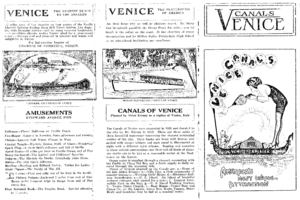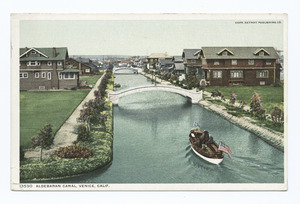Venice Canal Historic District facts for kids
|
Venice Canal Historic District
|
|

Venice Canal Historic District
|
|
| Location | Los Angeles, California |
|---|---|
| Built | 1905 |
| Architect | Moses Sherman, Eli Clark |
| NRHP reference No. | 82002193 |
Quick facts for kids Significant dates |
|
| Added to NRHP | August 30, 1982 |
The Venice Canal Historic District is a special neighborhood in Venice, a part of Los Angeles, California. It's famous for its beautiful man-made canals. These canals were built in 1905 by a developer named Abbot Kinney. He wanted to create a "Venice of America" that looked and felt like Venice, Italy.
Kinney gave the first canals names like Aldebaran, Altair, Cabrillo, Coral, Grand, Lion, and Venus. Later, other canals were built nearby. These included Carroll, Linnie, Howland, Sherman, Eastern, and another Grand Canal. People loved the lit-up canals with gondolas and pretty bridges. This helped sell homes in the new area.
By the 1920s, cars became very popular. Many people thought the canals were old-fashioned. So, in 1929, some canals were filled in to make roads. By 1940, the remaining canals were in bad shape. The sidewalks next to them were even unsafe. For over 40 years, the district stayed rundown. Many plans to fix the canals failed because of money problems or disagreements.
Finally, the canals were completely renovated in 1992. Workers drained them and built new sidewalks and walls. The canals reopened in 1993. Today, they are a very popular and expensive place to live. The neighborhood around the canals was added to the National Register of Historic Places in 1982. Many old houses have been updated, and new, modern homes have been built.
Water flows into the canals from the ocean through gates near Marina Del Rey. These gates open at low tide to let most of the water out. At high tide, they close, trapping the water for about three days. Then, the water is refreshed again.
Contents
Lost Canals of Venice
Before 1929, the Venice area had many more canals. There were thirteen canals, but only six remain today. The original canals were located between Abbot Kinney Boulevard, Pacific Avenue, Westminster Avenue, and Venice Boulevard.
Seven of these canals were turned into concrete roads by the City of Los Angeles. For example, Coral Canal became Main Street and Canal Street. Cabrillo Canal became Cabrillo Avenue. The traffic circle at Pacific and Windward Avenues now sits where the Venice Lagoon once was.
Bringing the Canals Back to Life
For many years, people tried to fix and improve the canals. Often, these plans faced problems and were canceled. One idea in the 1960s was to make the canals deep enough for large boats. This plan was stopped due to legal issues with land ownership.
In 1977, a group of residents formed the Venice Canals Resident and Homeowners organization. They wanted to create a plan to restore the canals. This group, later called The Venice Canals Association (VCA), gathered support from most property owners. They asked the city to design a new improvement plan.
Designing the New Canals
The city engineers, led by Luis Ganajas, created a plan. This plan featured straight, five-foot-high cement walls. It was designed for small, human-powered boats, not deep ones. This became known as the "Vertical Wall plan." The city estimated the project would cost about $15 to $18 million. Property owners would pay half through their taxes, and the city and federal government would pay the other half.
However, some people opposed this plan. They didn't want public sidewalks returned, didn't want to pay, or worried about wildlife. They even mentioned the California Least Tern, an endangered bird, that used the canals. Still, most residents supported the city's plan.
Finding a Better Solution
In 1983, Ruth Galanter became a City Council member. She inherited the Vertical Wall plan but had concerns about its environmental impact, cost, and safety. She asked a state agency to suggest other options. One idea was to use a material called Armorflex. This was a web of open cement blocks that would allow plants to grow. It would also create gentle slopes for birds and wildlife to enter and leave the canals.
Most neighbors did not like the Armorflex plan. Mark Galanty, who led the VCA improvement project, looked for a different material. He found Loffel Block. This material also allowed plants to grow and could be placed on a slope. It was safer for children and wildlife and cost less than Armorflex.
Testing the Materials
The city engineers were asked to design a plan using Loffel Block. Both Armorflex and Loffel Block test sites were installed in the canals. Native salt-water plants were planted in both. People observed them to see which worked better. Ducks seemed to prefer the Loffel Block. Many plants died in the Armorflex, which also started to sag. The Loffel Block site remained strong.
After several years, it was clear that Loffel Block was the best choice. It allowed plants to grow, was good for the environment, safer for children, and cost less. It also looked more like the original canal banks from 1906. With strong community support, the Loffel Block plan was approved.
The Canals are Restored!
Councilwoman Galanter also worked out a deal with the Summa Corporation, which owned land under the Ballona Lagoon. This ensured that water would continue to flow freely into and out of the Venice Canals.
The final approval came from the Coastal Commission. There was no opposition to the project. The estimated cost for the improvements was $12 million. Property owners paid about $6,600 to $7,800 over ten years, depending on their lot size.
Work began in March 1992 and finished in 1993. The project involved cleaning out the canals, removing old sidewalks, and building new ones. The Loffel Blocks were installed at a 55-degree angle along the canal banks. The footbridges over the canals were also rebuilt.
To celebrate the completion, the VCA held a carnival in 1993. They even rented two gondolas from Naples, a neighborhood in Long Beach, to give rides on the Venice Canals, just like in 1906! The community celebrated the 10-year anniversary of the restoration with another party in 2003.
Images for kids
See also










